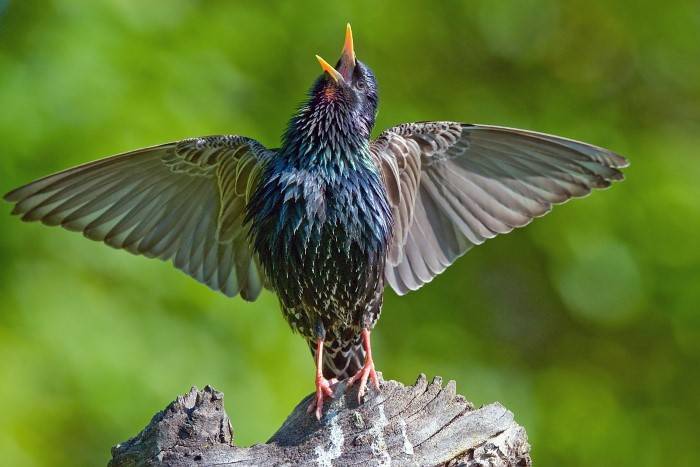In the avian realm, few species exhibit the remarkable versatility and adaptability of the Starling bird (Sturnus vulgaris). With their iridescent plumage, synchronized aerial displays, and diverse vocal repertoire, Starlings captivate observers worldwide. However, their complex behaviors and ecological impact often evoke polarizing opinions. In this comprehensive exploration, we delve into the multifaceted world of Starling birds, unraveling their evolutionary history, ecological significance, cultural connections, and conservation challenges.
Evolutionary History and Taxonomy
Origins and Spread:
The European Starling, native to Eurasia, was introduced to North America in the 19th century, where it quickly established thriving populations. Its rapid colonization of new territories is a testament to its adaptability and resilience in diverse environments.
Taxonomic Classification:
Belonging to the family Sturnidae, Starlings are passerine birds characterized by their medium-sized bodies, strong bills, and glossy plumage. The genus Sturnus encompasses several species, with the European Starling being the most widely recognized and studied.
Physical Characteristics
Plumage Variation:
Starlings display a striking variation in plumage, ranging from glossy iridescent black to speckled and mottled patterns. During the breeding season, males often exhibit brighter plumage and more prominent iridescence, while females and juveniles may have duller colors.
Mimicry and Vocalizations:
Renowned for their exceptional vocal abilities, Starlings are proficient mimics, capable of imitating a wide range of sounds, including other bird species, mechanical noises, and human speech. Their melodious calls and complex song patterns play a crucial role in communication and social cohesion.
Ecological Role and Behavior
Foraging Strategies:
Starlings are omnivorous opportunists, feeding on a diverse array of food items, including insects, fruits, seeds, and human-provided sources such as garbage and agricultural crops. Their adaptable feeding habits contribute to their success in urban, suburban, and rural environments.
Roosting Behavior:
One of the most spectacular phenomena associated with Starlings is their massive communal roosting displays, where thousands or even millions of birds gather at dusk to roost together. These murmurations, as they are known, serve various functions, including predator avoidance, information sharing, and thermoregulation.
Cultural Significance and Symbolism
Literary and Artistic Representations:
Throughout history, Starlings have inspired poets, writers, and artists with their enchanting murmurations and dynamic behavior. From Shakespeare’s references to murmurations in his plays to contemporary artworks capturing the fluidity and beauty of Starling flight, these birds have left an indelible mark on human culture.
Mythology and Symbolism:
In various cultures, Starlings symbolize different concepts and attributes, ranging from creativity and adaptability to communication and community. In Native American folklore, for example, Starlings are associated with the spirit world and serve as messengers between realms.
Conservation Challenges and Management Strategies
Invasive Species Concerns:
In regions where Starlings have been introduced, such as North America, they are considered invasive pests due to their impacts on native bird species, agricultural crops, and ecosystems. Efforts to control Starling populations include habitat modification, exclusion measures, and targeted culling programs.
Urban Wildlife Management:
In urban areas, where Starlings often congregate in large numbers, managing their presence can be challenging. Integrated pest management approaches, such as habitat manipulation, deterrents, and public education campaigns, aim to minimize conflicts between Starlings and humans while promoting coexistence.
Starling Bird
Citizen Science and Community Engagement
Monitoring and Research:
Citizen science initiatives play a crucial role in monitoring Starling populations, tracking their movements, and studying their behavior. Birdwatching enthusiasts and amateur ornithologists contribute valuable data to research projects and conservation efforts through bird counts, surveys, and observations.
Education and Outreach:
Engaging communities in bird conservation and fostering appreciation for Starlings can help cultivate a sense of stewardship and responsibility towards these birds and their habitats. Educational programs, public lectures, and wildlife rehabilitation centers provide opportunities for hands-on learning and interaction with Starlings.
Related Post:
Can Two Females Birds Have a Baby
How to Protect Grass Seed from Birds
Starlings exemplify the intricate interplay between biology, behavior, and cultural significance in the avian world. Despite their status as invasive pests in some regions, Starlings captivate us with their intelligence, adaptability, and mesmerizing murmurations. By embracing the complexity of Starling ecology and engaging in collaborative conservation efforts, we can strive towards a harmonious coexistence with these dynamic birds and foster a deeper understanding of our shared natural heritage. Let us marvel at the beauty of Starlings and recognize the invaluable role they play in the tapestry of life on our planet.




